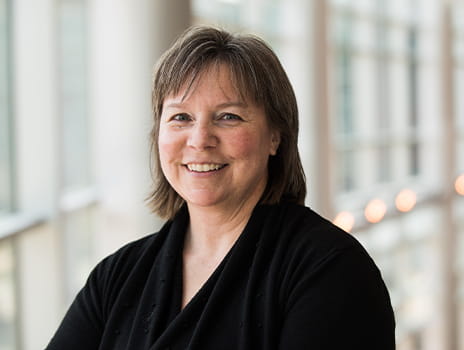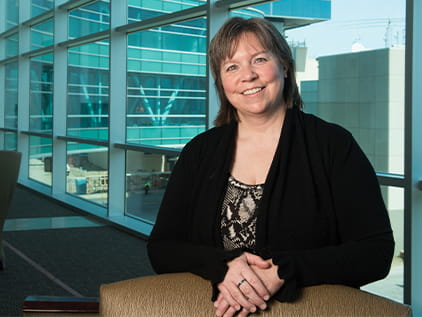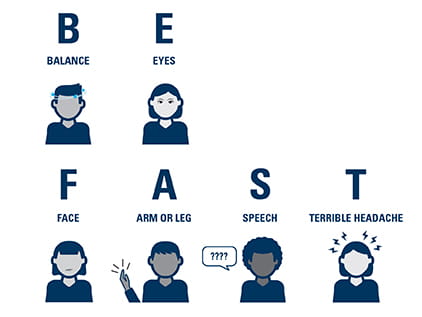Collaborative Care Enables Strong Outcome

The University of Kansas Health System is experiencing a high volume of patients seeking care for influenza and other respiratory illnesses. Whether you plan to visit the health system or not, learn how to keep yourself healthy.
In recognition of the upcoming Martin Luther King Jr. Day holiday, some of The University of Kansas Health System’s offices will have modified hours on Monday, January 19.

Terresa Roberts is used to putting others before herself.
As a mother of 5, a reserve deputy and a teacher of troubled youth at the Franklin County Juvenile Detention Center, Terresa's nature entails giving of herself to many.
That's a reason why, in the summer of 2016, the then 51-year-old brushed aside illness and tried to continue going about her responsibilities. On a liquid diet in preparation for a routine colonoscopy, Terresa attributed dizziness and lightheadedness to low blood sugar and the lack of solid food. She made tea, but dropped her cup. While she was cleaning up the spill, her 18-year-old son asked what was wrong.
"I didn't recognize anything major was happening," Terresa says. "I told my son I would drink some juice and then take a nap. He didn't buy it. He was worried and went to our next-door neighbor for help."
The neighbor had lost his mother to a stroke, which made him especially sensitive to Terresa's condition. He took one look at her and called 911.
"When the EMTs arrived to check me out, they said my blood sugar was 89 (normal)," Terresa says. "Strangely, that is a detail I remember and always will. I walked to the ambulance under my own power, but in the 1-mile drive between my home and the hospital, I went from code green to code red."
Terresa had suffered a stroke. At the local hospital in Ottawa, Kansas, she underwent a CT scan and IV tPA in accordance with stroke care conditions. But she would require specialized expertise.

Terresa was transferred to The University of Kansas Health System, which offers one of the nation's first Advanced Comprehensive Stroke Centers as certified by The Joint Commission. There, imaging revealed a large vessel occlusion – a clot blocking a blood vessel. Neurologist Michael Rippee, MD, and neurointerventionalist Michael Abraham, MD, decided to perform an embolectomy, a minimally invasive procedure in which the blood clot is removed through the groin.
"Terresa's was a challenging case because her stroke severity score was not particularly high, but if the obstructed artery were allowed to remain obstructed, the stroke could have become much more devastating," says Dr. Abraham. "We explored the risks and benefits and decided to proceed with endovascular therapy to retrieve the dangerous clot."
After the surgery, Terresa was transferred to the ICU. The next morning, occupational and speech therapists arrived to assess her.
"They had me walk down the hall and down a flight of steps," Terresa recalls. "They joked with me, 'Are you sure you've had a stroke?' I was essentially symptom-free."
Terresa had the stroke on a Sunday afternoon. She was home again the following Tuesday and prescribed a statin to further improve her already good cholesterol levels.
"I was told I could go back to normal activity," she says. "It almost made me laugh. I'd just had a stroke!"
She attributes her rapid recovery in part to her ongoing commitment to physical fitness. An avid walker and runner, Terresa completed a half marathon in 2012 and had placed second in her age group in a 5K run just a few months before the stroke. As a reserve deputy, physical strength is important to her role, and she works hard to keep it up.
Terresa cites the exceptional care she received as critical to her positive outcome.
"Everyone here is absolutely amazing," she says. "Beyond the fantastic healthcare, they really make you feel like they care about you as a person, and your family members, too. It really helped us feel at ease and meant a lot."

Terresa also was impressed with the collaboration of physicians across disciplines. She had health concerns in her history long before she had the stroke. As a teenager, she was diagnosed with mitral valve prolapse, a condition in which the flaps of the heart's mitral valve do not close evenly. She was prescribed beta blockers. Later, as a reserve deputy, she had to experience the shock of a Taser stun gun as part of her training. Shortly after that shock, she temporarily lost vision in her left eye. When she explained her history to her eye doctor, she was encouraged to see a cardiologist. She did so, choosing a nearby provider in Lawrence, Kansas, who discovered a hole in Terresa's heart. She was advised to take a baby aspirin daily, but that no other treatment was necessary.
This became especially important following her stroke. Aware of her history, the stroke team involved cardiologist Matthew Earnest, MD, in Terresa's care. Dr. Earnest ordered a Zio Patch, a home heart monitor, followed by the insertable LINQ cardiac monitoring device. These tests revealed an atrial fibrillation, an irregular heart rhythm that is a common cause of strokes. Demonstrating the value of multidisciplinary care, Dr. Rippee considered the finding and chose a different secondary stroke prevention medication.
"I really appreciate that my neurologists and cardiologists talk to each other," Teresa says. "There is a lot of great communication here, a lot of working together to decide what to do. I really feel that I have a team working proactively for me."
Dr. Rippee cites multidisciplinary collaboration as a crucial component to Terresa's successful outcome.
"Terresa's story is a perfect example of the team approach to stroke care," Dr. Rippee says. "It began with the team at her local ER – where the team called me to discuss her immediate treatment – and continued through her transfer to us. Dr. Abraham and I worked together to make the decision to remove the clot, and we then collaborated with our cardiologists to determine the reason she developed the stroke at such a young age. We together uncovered the heart arrhythmia, and this information enabled me to adjust her medications to reduce her risk for future strokes."
In addition, the care team enrolled Terresa in a clinical trial for which The University of Kansas Health System is one of just 8 sites in the country. The Optimizing Patient's Selection for Endovascular Treatment in Ischemic Stroke (SELECT) trial will support discovery and learning in neurosciences imaging to benefit future patients.

Today, Terresa feels healthy and strong. She is pursuing a master's degree in education in learning technologies from Ottawa University. She has a new appreciation for health threats that can strike without warning.
"You need to listen to your body," she says. "We always want to believe we're OK, but sometimes, we need to pay closer attention. A stroke can happen to anyone."
Patient testimonial: As with all treatments, individual patient results vary. It is important to discuss your treatment options with your healthcare provider.
We offer a variety of appointment types. Learn more or call 913-588-1227 to schedule now.